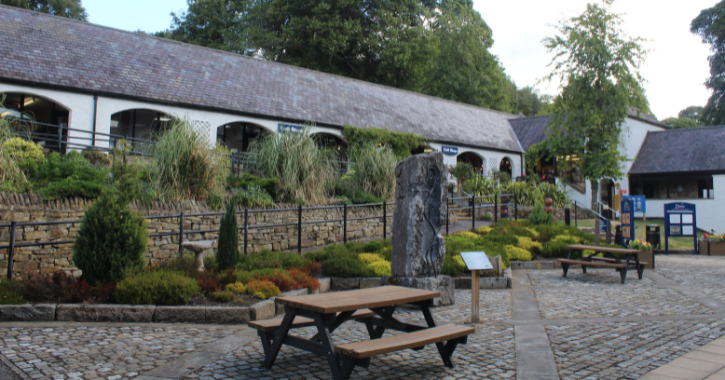The new Roof of England Walk is a 188-mile (301km) circular route that takes walkers on a journey through the North Pennines National Landscape and UNESCO Global Geopark.
With dramatic landscapes, wildlife-rich habitats, and welcoming villages, this multi-day walk is perfect for anyone seeking a real outdoor adventure. And if you’re planning to explore the trail, the Durham Dales are packed with some of its most breathtaking highlights.
.png)
What is the Roof of England Walk?
The Roof of England Walk is a 14-day, circular trail that links together some of the highest footpaths in Northern England. Its name reflects the elevated position of the North Pennines uplands, where walkers can enjoy big skies, sweeping moorlands, and unspoilt horizons.
The route crosses three counties - Durham, Cumbria, and Northumberland, with an additional section dipping into the Yorkshire Dales National Park. Walkers can complete the full route in a continuous trek, split it into four shorter breaks of three to four days, or enjoy individual day walks along each section.
.png)
Why Walk the Roof of England?
This new trail is not just about distance; it’s about discovery. Along the way, you’ll encounter:
• Dramatic waterfalls including Low Force, High Force, and Cauldron Snout in the Durham Dales.
• High moorland paths with spectacular open views.
• Peaceful riverside trails and ancient woodland.
• Historic landmarks such as Blanchland Abbey and Dukesfield Arches.
• Wildlife encounters, with wading birds, hay meadows in summer bloom, and the chance to spot rare species in unique habitats like blanket bogs.
For hikers who love both challenge and variety, the Roof of England Walk offers the perfect mix.
Highlights of the Roof of England Walk in Durham
While the route spans multiple counties, Durham’s section is a true jewel in the crown. The Durham Dales provide some of the most memorable and scenic stretches of the entire walk.
Here are the key Durham highlights, stage by stage:
.png)
Blanchland to Edmundbyers
Start in the historic village of Blanchland, with its 12th-century abbey remains, before crossing heather moorland and rolling dales to the pretty village of Edmundbyers.
Don’t Miss: Pop into the Lord Crewe Arms, a 12th-century inn steeped in history, for a hearty meal or a cosy drink by the fire. It’s also the perfect place for a peaceful overnight pit-stop.
.png)
Edmundbyers to Wolsingham
This section leads through open countryside and farmland, before descending into the bustling market town of Wolsingham, known as the gateway to Weardale.
Don’t Miss: Visit the Weardale Railway, a heritage line running through the dales.

Wolsingham to Stanhope
Follow riverside paths and scenic trails into Stanhope, home to the Durham Dales Centre and the famous fossil tree, a reminder of the area’s deep geological heritage.
Don’t Miss: The Durham Dales Centre in Stanhope, where you’ll find local crafts, exhibitions, visitor information centre and a café.
.png)
Stanhope to St John’s Chapel
This route climbs into open moorland, with stunning panoramic views, before reaching St John’s Chapel, a charming Weardale village surrounded by rolling hills.
Don’t Miss: Step into the nearby Weardale Museum at Ireshopeburn, a community-run gem telling the story of Weardale’s people, history, and culture.
.png)
St John’s Chapel to Saur Hill Bridge
Expect wild uplands, stone walls, and big skies, a real taste of the North Pennines wilderness.
Don’t Miss: Pause along the way to simply enjoy the peace and remoteness. This section is all about the natural landscape.
.png)
Saur Hill Bridge to Middleton-in-Teesdale
This stage takes you into Teesdale, one of the jewels of the Durham Dales. Walkers can enjoy routes towards some of the most iconic natural sights in the Durham Dales - the dramatic cascades of Low Force, High Force, and Cauldron Snout.
Don’t Miss: High Force Waterfall, one of England’s most powerful waterfalls, a breathtaking natural wonder. High Force Hotel is the ideal place to refuel or stay overnight, just a short walk from the falls. Nearby Low Force Waterfall is a picturesque cascade often used as a filming location, perfect for photos and picnics.
.png)
Middleton-in-Teesdale to Tan Hill Inn
Leaving the historic market town of Middleton-in-Teesdale, the trail guides you through a landscape shaped by water, passing several striking reservoirs that supply both scenery and tranquillity. The path then climbs into open moorland, offering vast views across the Durham Dales before leading you towards the wild high ground on the border with Yorkshire.
Don’t Miss: The chain of reservoirs, including Grassholme, Selset, and Balderhead, which add a distinctive beauty to this section of the walk. Grassholme Observatory, where you can explore the dark skies of the North Pennines - one of the best stargazing locations in the UK.
Finishing at the legendary Tan Hill Inn - Britain’s highest pub at 1,732ft above sea level, known for its warm welcome, roaring fires, and real ale.
.png)
How to Plan Your Walk
The Roof of England Walk is flexible, meaning you can:
• Walk the entire 188 miles over 14 days.
• Break it into four shorter adventures of 3–4 days each.
• Explore individual day routes, perfect for shorter trips or weekend stays.
• Convenient starting points in the County of Durham include Blanchland, Edmundbyers, Wolsingham, Stanhope, St John’s Chapel, Saur Hill Bridge, and Middleton-in-Teesdale.
The route is accessible by public transport, with train and bus links across the county.
Discover More
The Roof of England Walk is a trail for every season, every pace, and every type of walker. Whether you’re chasing waterfalls in Teesdale, exploring moorland around Weardale, or discovering the heritage of Blanchland, the Durham Dales promise unforgettable moments on this epic new walking route.
Explore full route details and plan your visit at RoofofEnglandWalk.org.uk
Related
Comments
Nobody has commented on this post yet, why not send us your thoughts and be the first?



 to add an item to your Itinerary basket.
to add an item to your Itinerary basket.
.png)





